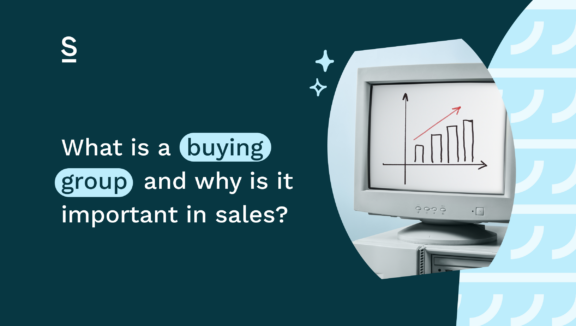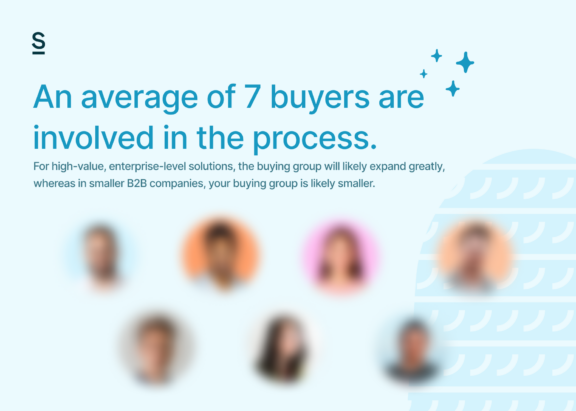What is a buying group and why is it important in sales?

A ‘buying group’ refers to the people within a company who are responsible for making purchasing decisions for new products or services.
It’s important in sales that you understand the purpose of buying groups, how to identify the responsibilities of individuals in a buying group, and how to sell to them.
Key Highlights
What is a buying group?
In B2B, a buying group refers to a collection of individuals within an organization who are collectively responsible for deciding whether or not to buy your product or service.
Buying groups can be formal teams who’ve been set up to actively decide on purchase decisions, but more frequently they’re informal networks. Think of a CMO who may reach out to a few of their team to ask whether they’ve used a piece of software before and solicit their opinion.
This group typically encompasses a range of roles, each contributing different perspectives, expertise, and levels of authority to the decision-making process.
Buying groups will vary depending on the organization and the industry, but there are some common responsibilities you can expect to find in most buying groups:
Initiators: The ones who first identify the need for a product or service. (These are often the ones experiencing the pain point or responsible for identifying the pain point that your product or service solves)
The Users: The end users of the product or service, who often provide feedback on the requirements. (Often these can be champions for your product or service by advocating for its necessity.)
The Gatekeeper: Controls the flow of information and access to other members of the group.
The Influencers: Individuals who sway the buying decision with their expertise or authority.
Decision Makers: The person with the final say on whether a purchase goes ahead, often a senior executive.
The seller’s relationship with each of these roles is absolutely crucial.
In fact, 84% of B2B decision-makers begin their buying process with a referral.
Build solid relationships with the whole buying group, not only so you can depend on them during the sales cycle, but also after.
The Importance of Buying Groups in Sales
An average of 7 decision-makers are now involved in the B2B buying process.
The complexity and length of sales cycles have increased. Giving a single sales pitch to a solitary decision-maker is no longer sufficient and salespeople must learn to tackle decentralized decision-making frameworks.
As an SDR of BDR, you’re now tasked with addressing a diverse range of needs, concerns, and motivations. Each member of the buying group holds unique criteria for judging potential purchases – from budget constraints and technical requirements to strategic alignment or security expectations – your sales strategy needs to resonate with the distinct priorities of each stakeholder in the buying group.
But how does it impact the sales process?
The involvement of multiple decision-makers can extend the sales cycle. Consensus building becomes an integral part of the purchasing process and sales professionals therefore need to nurture each relationship within the group, providing tailored information and reassurances based on the individual’s concerns.
Larger buyer groups can also impact customer retention and lifetime value. This can go both ways. If the sales team fails to convince all stakeholders, customer retention may decrease. But if a majority of stakeholders are committed, it’s less likely that one member of the buying group can influence the decision.
Common Questions About Buying Groups
How big is a buying group
The size of a B2B buying group can vary significantly – part of the challenge is identifying the buying group and its size – but a typical buying group ranges from 3 to 10 people.

How to sell to a buying group
Selling to a buying group requires a multi-touch, multi-channel strategy that is also multi-concern – meaning able to resolve the concerns of each member of the buying group.
Here’s a few points to consider:
Tailored Communication: Customize your communication to address the specific interests and challenges of each role within the buying group.
Unified Solution Presentation: While tailoring individual communications, ensure your overall message remains cohesive, presenting your product or service as a unified solution that meets the collective needs of the group.
Facilitate Consensus: Recognize the internal dynamics and possible conflicts within the group. Offer tools or processes that help them reach a consensus, such as workshops, demos tailored to various functions, or comprehensive case studies.
Long-term Engagement: Establish ongoing dialogues with all members of the buying group. This includes post-sale support and check-ins to ensure the solution continues to meet the group’s evolving needs, fostering loyalty and opening doors for future expansions or referrals.
How is the buying group evolving?
Digital Transformation

A lot of the buying process happens online without the input or control of salespeople. Over the years, the availability of information has increased, enabling buying groups to research independently before even talking with sales.
Your sales strategy needs to focus on providing value beyond what is readily available online, like insights into industry trends, personalized assessments, or strategic consultations.
Demand for Personalized Solutions
As B2B buyers become more sophisticated, there is a growing expectation for solutions that can be closely tailored to their specific business needs. To compete, sales professionals need a deeper understanding of the buyer’s industry, business model, and competitive landscape, and the ability to customize solutions in a way that resonates with all members of the buying group.
Let’s wrap it up!
A buying group consists of individuals within a company responsible for making purchasing decisions.
For salespeople, research and preparation are crucial to addressing the concerns, pains, questions, and intentions of the varying roles in the buying group. Even more so because 82% of B2B decision-makers think sales reps are unprepared – it’s the sales rep’s responsibility to prove them wrong, convince them of the value, and close the deal.
Selling to buying groups requires tailored communication, consensus building, and long-term engagement strategies.
The evolution of buying groups, driven by digital transformation and demand for personalized solutions, emphasizes the need for sales strategies that provide value beyond readily available information.
Save 3 hours per week by cutting out sales admin with Surfe.
Surfe allows you to automatically sync the details, contact information, and conversations you have on LinkedIn to your CRM in one click.


